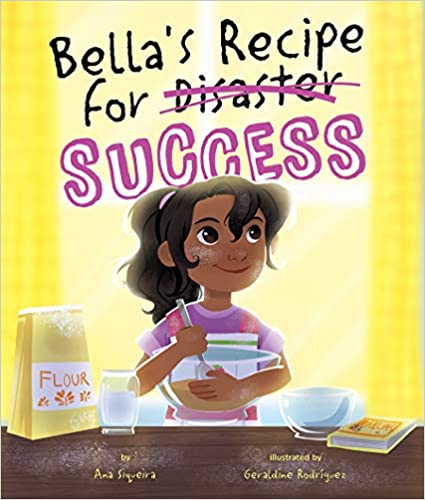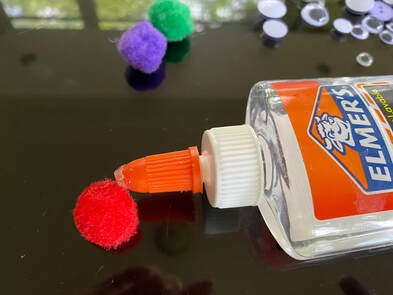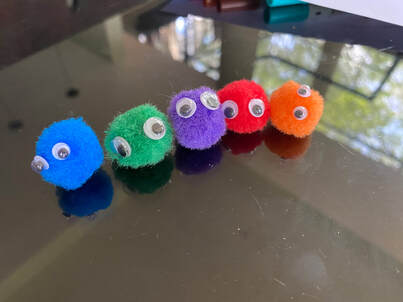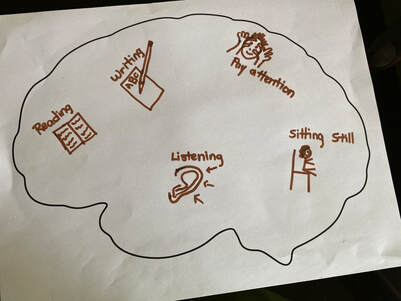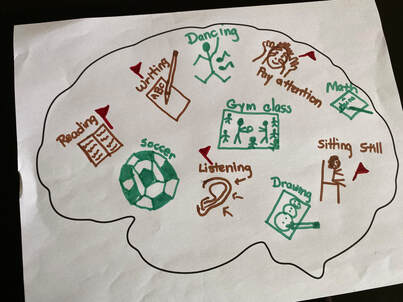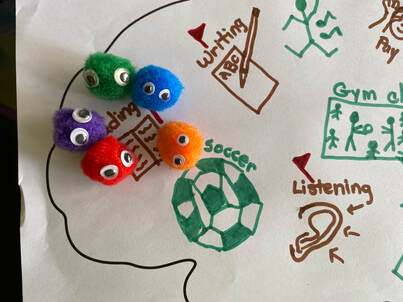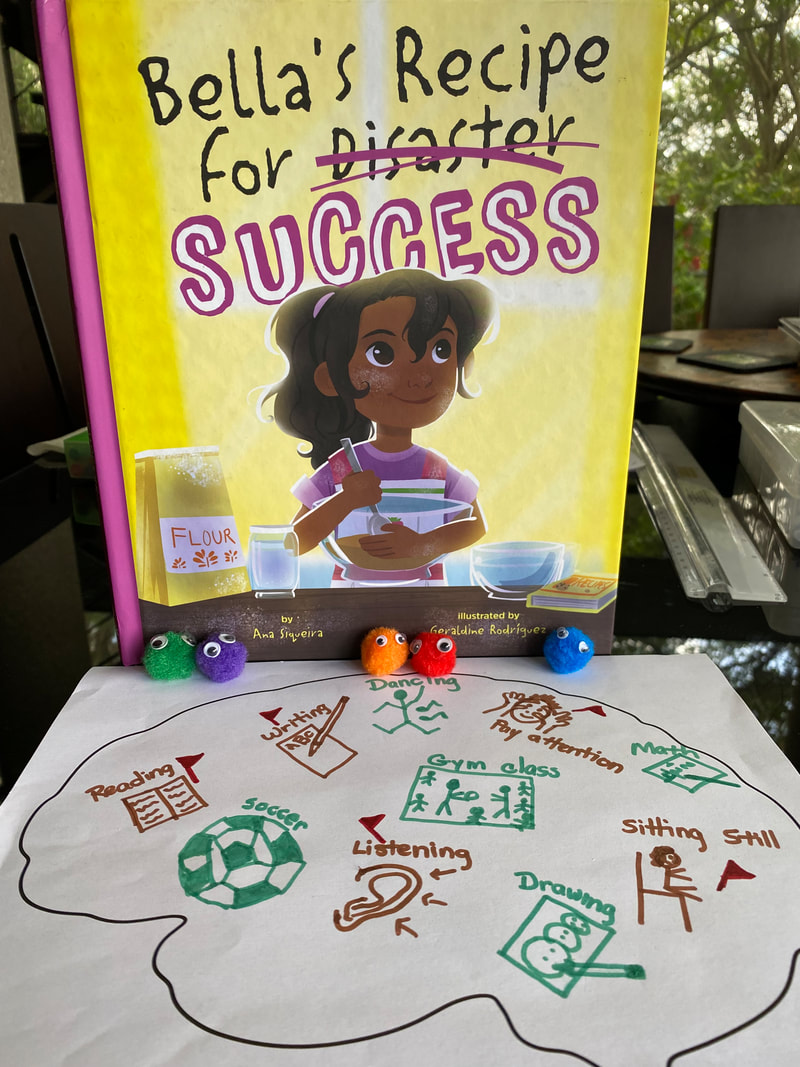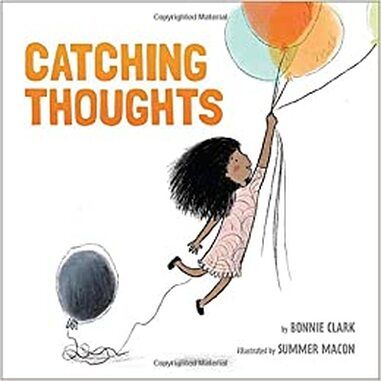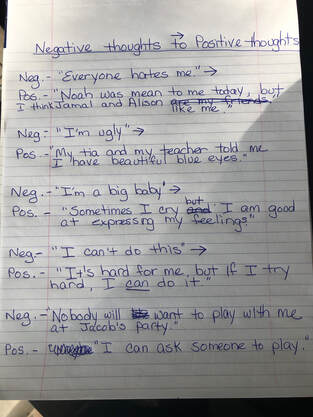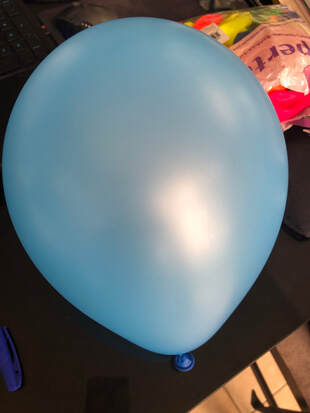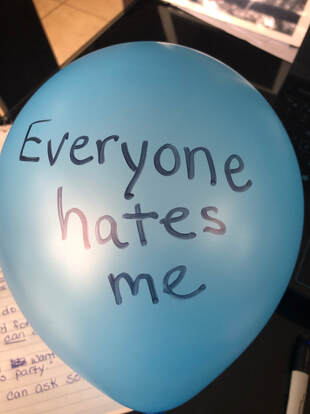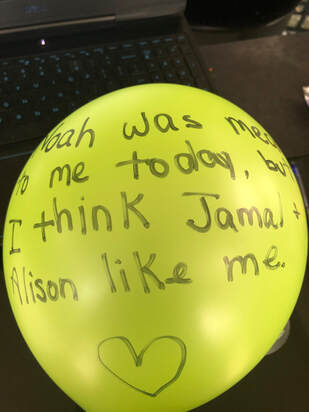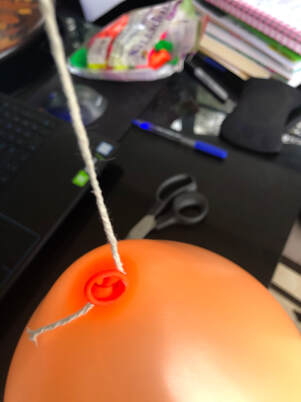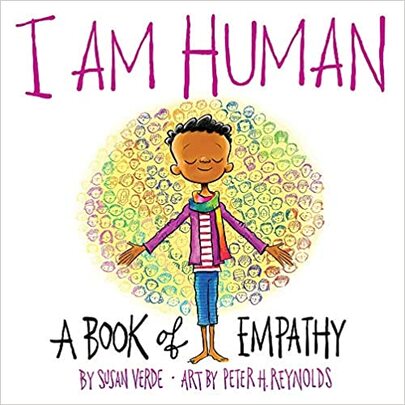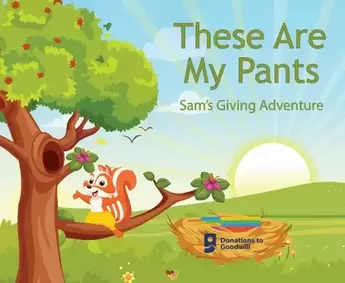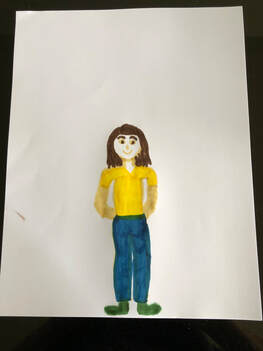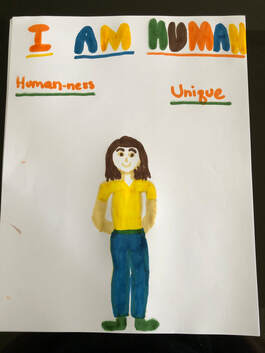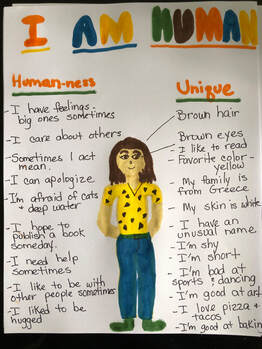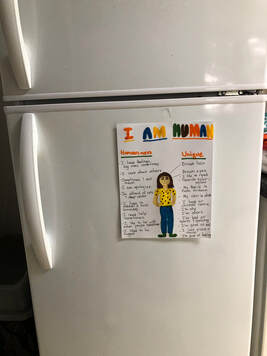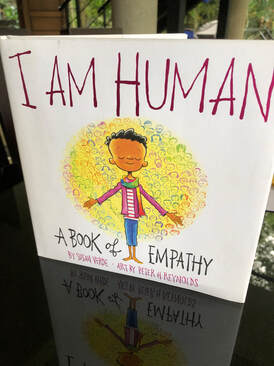A Book Review of Bella's Recipe for Success
Bella, the main character, upon witnessing the special skills of her siblings, searches for her own strengths. However, after half-hearted attempts at gymnastics and piano-her sibling's skills-she comes up empty. Then she decides that maybe baking is an area in which she can excel, like her abuela (grandmother). After much frustration and discouragement with her baking attempts, she persists. In fact, she tries so many times that I'm pretty sure she ran out of vanilla in the process! And with a nice touch by the illustrator, she made a major flour mess along the way (that I can totally relate to!). Eventually, Bella gets the recipe just right and all of her practice is rewarded with delicious cookies (oops, until she trips on the cat and they go flying across the room!). Through this story, Ms. Siqueira highlights the universal lapses of self-confidence that touches all of us from time to time. When we see others' successes, we may become discouraged, or even a little envious. Sometimes it seems that a certain skill comes easy for another person. We don't see the grit and hard work that the person plowed through to get to that skill level. But, if you've lived long enough, you know that nothing in this world comes easily. Everything takes hard work and lots of practice, which is the message of the book. Although, let's face it, even though EVERYTHING takes practice, we all do have strengths and weaknesses (or challenges). These are based on heredity, innate neurological functioning and/or early learning experiences. Certain skills may come a little easier for us than other skills. To borrow wisdom from abuela in the book, "We're all good at different things." As a side note, I especially love the value placed on the wisdom and experience of the abuela in the story, which in our culture of technology has become undervalued. While reading about Bella, I thought of the many kids I have encountered in my practice. Many of whom have experienced more than their fair share of defeat in life. That defeat may be due to their family circumstances, physical disabilities, mental health challenges or learning disabilities. Therefore, the themes raised in this book may become more pronounced for them, as their self-esteem has suffered. The common response of many of these children when confronted with a challenge often is "I can't." Therefore, this book would be especially helpful in these circumstances. Often kids with learning disabilities, for example, compare themselves to other students in their class and feel inadequate. When working with these kids, I encourage them to explore their own strengths instead of dwelling on their challenges. For example, maybe reading is difficult for you, but you have a real science mind. Maybe you struggle with math, but you are a great soccer player. Maybe you don't walk well due to your disability, but you are a reading whiz. Maybe you struggle with paying attention, but you have amazing art skills. Maybe you lose your temper easily, but you have a great sense of humor. A general idea on how I present this concept to kids is as follows: Some parts of our brains (challenges) don't work as well as other parts (strengths). So, those challenge parts have to depend on other parts of the brain to kick in and help. I refer to those helpers in the brain as "brain buddies." In order to get the "brain buddies" to work together, it takes much extra work and time, and can be frustrating. But, many skills that are hard for us are very important. So, we can't let the "brain buddies" give up. When we practice, we cheer on the "brain buddies!" However, other parts of our brain, our strengths, work well and don't have to rely on the 'brain buddies' to help out. Those things still require much practice, but maybe aren't as frustrating to master. Displayed below, is a project using the above concept. This works well with kids that struggle with defeat. It is a perfect accompaniment to this book. Bella's Recipe for Success is about hope. Hope in our abiities to accomplish things and confidence in our abilities to contribute to the world in some way. Our mental health depends on this! If you'd like to try your own hand at baking, Bella's special ethnic recipe is included at the back of the book! To purchase this book and to check out upcoming books by the author, Ana Siqueira, click here. An Activity Idea for Bella's Recipe for SuccessFirst of all, of course make the polvorones from the recipe in the book. You can snack on those while doing the project below! Remember, if you mess them up the first time, try, try again! In this month's project, we are going to talk about our own challenges and strengths, and draw them in our brain. Then, we are going to make warm and fuzzy "brain buddies" to help out with our challenges when needed. The "brain buddies" represent other parts of the brain that we need to access to help the part of the brain that is struggling. This is especially helpful for kids with learning problems. This project helps demonstrate why learning some skills is harder and takes longer to master than others. And, of course, to normalize the fact that we all have our challenges and strengths. Enjoy!
4 Comments
A Book Review of Catching Thoughts
Catching Thoughts is an empowering picture book for children ages 4 - 8. The author, Bonnie Clark, introduces thoughts using a balloon analogy, which helps children think more tangibly about this abstract concept. The main character starts out with "just a teeny, tiny, little thought" that grew into a bigger and more bothersome thought that took over her mind. "It seemed like there was no more room in my head for anything but the one horrible thought." After many attempts, she was unable to get this big, negative thought out of her mind. When she acknowledged the thought, she was able to see that it wasn't as powerful as it appeared. Only then was she able to catch other thoughts that were more positive. When the negative thought started to come back, she simply acknowledged it and "gently pushed it to the side." This is an important insight in dealing with negative thoughts. They can't be forced out, but if they are acknowledged and consciously set aside, one is able to make room for accepting more positive thoughts. Through her empowering language, Ms. Clark demonstrates to children that they have a choice to change their negative self-talk. The illustrator, Summer Macon, does a wonderful job with the pictorial representation of the change in mood and behavior using color, facial expressions and actions that corresponds to pulling in positive thoughts. I strongly recommend this book to help children learn, and adults remember, the power they have over their thoughts. To reinforce the concept of replacing negative thoughts with positive ones, I have included an activity below. To purchase the book or find fun activities, check out the author's website here. Activity Idea for Catching Thoughts Materials needed: -pen/pencil -paper -Balloons (various colors) -Black permanent marker -string -scissors
A Book Review of |
| I Am Human A Book of Empathy Written By: Susan Verde Illustrated By: Peter H. Reynolds Published By: Abrams Books for Young Readers Recognizing our connection to each other through our humanity and empathizing with the plight of others is key to making this world a better place. I Am Human introduces these concepts to the youngest among us. It has become clear through this pandemic and the Black Lives Matter movement that our culture is lacking empathy and the ability to put ourselves in someone else's shoes. Teaching our children the importance of human connection, acceptance and empathy towards others will go a long way in improving our culture. The ability to care about the impact of our actions and behaviors on others is crucial. |
I Am Human sends an important message to all of us, but is most appropriate for children ages 3-8. Susan Verde skillfully weaves many layers into this simple book.
The larger take away is that we are all human. This sounds obvious, but the reality in this world is that is not how we treat each other. We are all human regardless of the color of our skin, different abilities, the country we are from, our religion or if we are from a poorer or richer part of town. We are all connected by our human-ness and are all unique in our own way. This book celebrates the human potential of feeling empathy and compassion toward ourselves and others.
The smaller messages relate to the fact that the human condition is imperfect. We all have our strengths and weaknesses and we should respect those things in ourselves and others. I Am Human is a hopeful book in that it portrays the journey of being human as having challenges and possibilities. We all have feelings that we express in different ways. Part of being human is being afraid of things sometimes or feeling sad occasionally or hurt or angry about something somebody said to you. We have the ability to make choices. We can apologize for our mistakes and try to do better. We can choose to be helpful to others if they are struggling or kind to ourselves.
The art by Peter H. Reynolds is simple, yet beautiful. It shows the connection between others and hopefulness of the human condition. The book includes a Loving/Kindness Meditation at the end.
I recommend this book for all children to teach them these human ideals from a young age and give them the reassurance and knowledge that they are part of something bigger and are not alone. It reinforces a sense of community that will help all of us get through difficult times. You can find this book and others in the I AM Series by Susan Verde and Peter H. Reynolds on her website at https://www.susanverde.com/susans-books.
As an example of showing empathy toward others, I recommend this follow up book that reinforces the joy of helping others.
The larger take away is that we are all human. This sounds obvious, but the reality in this world is that is not how we treat each other. We are all human regardless of the color of our skin, different abilities, the country we are from, our religion or if we are from a poorer or richer part of town. We are all connected by our human-ness and are all unique in our own way. This book celebrates the human potential of feeling empathy and compassion toward ourselves and others.
The smaller messages relate to the fact that the human condition is imperfect. We all have our strengths and weaknesses and we should respect those things in ourselves and others. I Am Human is a hopeful book in that it portrays the journey of being human as having challenges and possibilities. We all have feelings that we express in different ways. Part of being human is being afraid of things sometimes or feeling sad occasionally or hurt or angry about something somebody said to you. We have the ability to make choices. We can apologize for our mistakes and try to do better. We can choose to be helpful to others if they are struggling or kind to ourselves.
The art by Peter H. Reynolds is simple, yet beautiful. It shows the connection between others and hopefulness of the human condition. The book includes a Loving/Kindness Meditation at the end.
I recommend this book for all children to teach them these human ideals from a young age and give them the reassurance and knowledge that they are part of something bigger and are not alone. It reinforces a sense of community that will help all of us get through difficult times. You can find this book and others in the I AM Series by Susan Verde and Peter H. Reynolds on her website at https://www.susanverde.com/susans-books.
As an example of showing empathy toward others, I recommend this follow up book that reinforces the joy of helping others.
| These Are My Pants Written by: Jane and Katelyn Plank Ilustrated by; Aniqa Ashfaq This is a self-published book, that is not only about the virtue of giving to others, but also sets an example for giving as a portion of the book proceeds go towards Goodwill. I encourage you to purchase this book and use it as an example of being human and showing empathy toward others. |
Reading These Are My Pants provides an excellent opportunity to put the concept into action and have your child participate in an act of giving to others. It could be something of theirs that they are willing to give up to help others, something new that you buy together, or a service that the child can provide in the mission to help another human. Share the joy of giving with your child!
To learn more about These Are My Pants and to purchase the book, go to their website at https://www.plankbooks.com/.
To learn more about These Are My Pants and to purchase the book, go to their website at https://www.plankbooks.com/.
Activity Idea for I Am Human A Book Of Empathy
We are all connected with our human-ness, even though we are all unique in many ways. My suggestion is to pose two questions to your child after reading the book.
What makes you human?
What makes you unique?
Use those ideas to complete the following activity.
Materials needed:
8.5 x 11 paper or a roll of paper cut to the size of the child
markers or crayons
pencil
Directions:
If you have a roll of paper that you could have the child lay on and trace them, this would be the funnest way to continue. I don't have a paper roll or a child with me, so I will draw the child on a regular size paper. Either way is fine.
What makes you human?
What makes you unique?
Use those ideas to complete the following activity.
Materials needed:
8.5 x 11 paper or a roll of paper cut to the size of the child
markers or crayons
pencil
Directions:
If you have a roll of paper that you could have the child lay on and trace them, this would be the funnest way to continue. I don't have a paper roll or a child with me, so I will draw the child on a regular size paper. Either way is fine.
| 1. Have child lay on the paper on his/her back and trace around their body with a pencil. Then have child draw on and color their hair, eyes, clothes, etc. Or draw child outline on sheet of paper and have them color in details of themselves. Encourage them to make it look like their unique selves with hair color, skin color, eye color etc. Make sure to leave room around the drawing for writing. 2. Write I AM HUMAN at the top of the page and label one side with human-ness and the other, unique. 2. Around the portrait of themselves, discuss and write the things that make them both human and unique. The photo shows some examples. 3. Hang completed project on refrigerator or wall so they can see often. 4. Share with the child how you are different and the same as them. Have fun! |
Follow me on Twitter, Pinterest and LinkedIn
Categories
All
Absent Dad
Acceptance & Commitment -Therapy Skills
Acceptance Of Others
ADHD
Adoption
Anger Management
Anxiety
Body Autonomy
Cognitive Behavioral Therapy Skills
Consent
Coping With ADHD
Coping With Depression
Coping With Feelings
Depression
Disability Awareness
Disappointment
Divorce
Domestic Violence
Empathy
Fear
Feelings General
Feelings-General
Foster Care
Gender Identity
Giftedness
Grandparents As Guardians
Grief & Loss
Growth Mindset
Incarcerated Parent
Kindness
Kinship Care
Learning Disabilities
Making Friends
Mindfulness
Negative Self Talk
Parental Anger
Parental Arguing
Parent W/Mental Illness
Parent W/Substance Abuse
Racial Injustice
School Lockdown Drills
Seizures
Self Esteem
Sensory Issues
Separation Anxiety
Sexual Abuse
Sexual Abuse Prevention
Shyness
Standing Up For Others
Suicide
Supporting A Friend
Temper Tantrums
Terminal Illness
Trauma
White Privilege
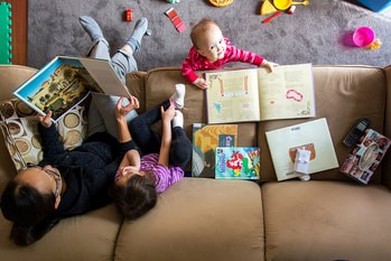
 RSS Feed
RSS Feed
